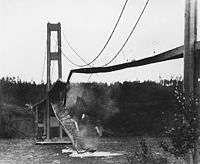Allen Street Bridge disaster
| Allen Street Bridge | |
|---|---|
 Allen Street Bridge as it appeared in 1910 | |
| Coordinates | 46°08′42″N 122°54′51″W / 46.14500°N 122.91417°WCoordinates: 46°08′42″N 122°54′51″W / 46.14500°N 122.91417°W |
| Other name(s) | Kelso-Longview Bridge[1] |
| Characteristics | |
| Design | Suspension |
| Total length | 600 feet (182.9 m) |
| Longest span | 300 feet (91.4 m) |
| History | |
| Opened | 1906 |
| Collapsed | January 3, 1923 |
 Allen Street Bridge Location in Washington (state) | |
Allen Street Bridge was a bridge over the Cowlitz River between Kelso, Washington and Longview, Washington that collapsed on January 3, 1923.
Construction
The bridge was a bascule bridge with a 600-foot (180 m) central span, built in 1906. It was renovated in 1915, but many residents refused to use the bridge due to its poor condition.[2]
Collapse
The collapse occurred the day after a log jam of over 3 million board-feet of runaway log boom piled up against the bridge was cleared. This was concluded by structural engineers to have weakened the bridge.[2] According to another source, the original old, rotten bridge deck had been overlaid by another layer of timbers which, combined with the soaking of the entire deck thickness, overloaded the span.[3]
The collapse occurred during evening rush hour with workers coming home from the Longview mills.[4] A stalled car caused traffic to bunch on the bridge; according to witnesses, the bridge was carrying about 20 vehicles and 100 to 150 pedestrians when a support cable failed for unknown reasons.[5] The two supporting towers fell and the 300-foot center span of the bridge collapsed.
Initial contemporary newspaper reports stated that up to 80 people were killed in the collapse, with some witnesses saying 150.[6] By January 9, reports were that 19 people had been killed.[7] The figure compiled by authorities stood at 17, but probably did not account for many transient workers. Many of the missing bodies were probably carried down the Cowlitz to the Columbia River and then out to sea.[4] An estimate today is that 35 lives were lost.[8] Using even the lowest estimate of 17, as of 2014, the disaster stands as Washington's greatest loss of life caused by bridge failure.[9][2][5][10]
Aftermath
A new four-lane vertical-lift drawbridge, of steel and cement construction, was under construction when the 1906 bridge collapsed. It was to connect Kelso with the new planned city of Longview on the west side of the Cowlitz. It was built by the Washington State Highways Department (now Washington State Department of Transportation) and went into service in March or April 1923.[2]
The bridge loss is the first in a list of seventy accidental losses compiled by the Washington State Department of Transportation between 1923 and 1998.[11] This disaster brought about bridge inspection programs conducted by the state agency and counties.[3][12]
References
Notes
Sources
- McClary, Daryl C. (August 3, 2005), Allen Street (Kelso) Bridge collapses, with loss of life, on January 3, 1923, HistoryLink
- Driscoll, Matt (May 24, 2013), "Top 5 Most Memorable Bridge Collapses in Washington State History", Seattle Weekly
- Haeck, Tim (May 24, 2013), Unfortunate history of bridge disasters in Washington, KIRO (AM)
- Miller, George R.; Watson, William R. (2011), Kelso, Cowlitz County Historical Museum (contributor), Arcadia Publishing, ISBN 9780738575469
- Collapse of Kelso bridge causes 80 casualties, 62 (53), United Press, January 4, 1923 – via The Stanford Daily
- "Where collapse of bridge cost 19 lives", Chicago Tribune, January 9, 1923
- "Cowlitz Bridge Collapse Fatal to Many", Popular Mechanics, March 1923
- "Five memorable state bridge collapses include two from Peninsula", Peninsula Daily News, May 25, 2013
- Holstine, Craig E.; Hobbs, Richard (2005), Spanning Washington: Historic Highway Bridges of the Evergreen State, Washington State University Press
- Drone, Grace (June 24, 2013), Failed Bridges In Washington's History, KUOW-FM
